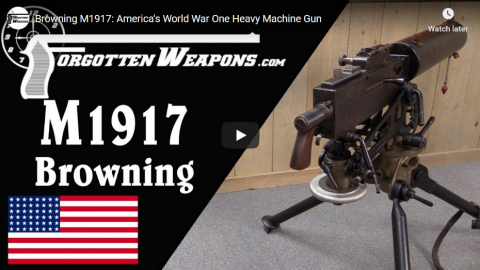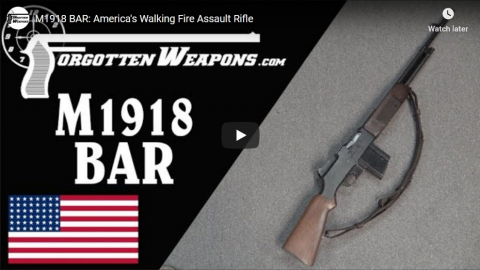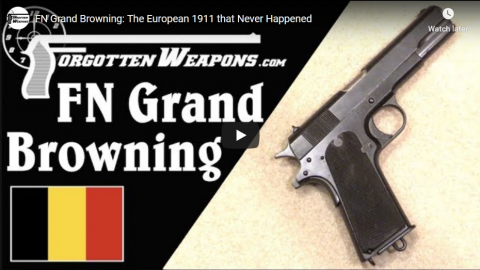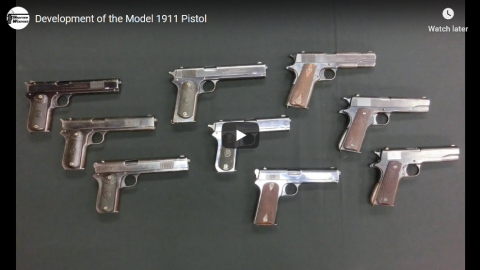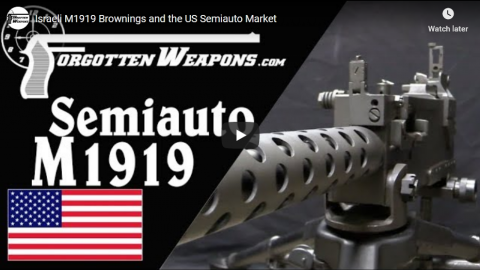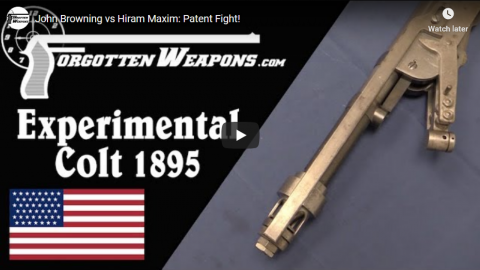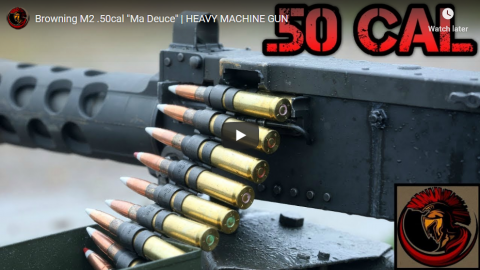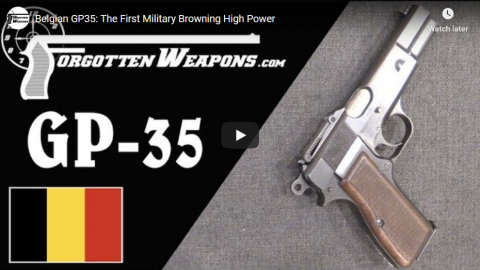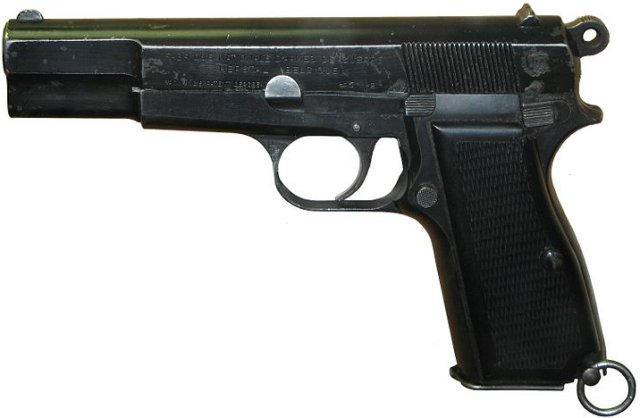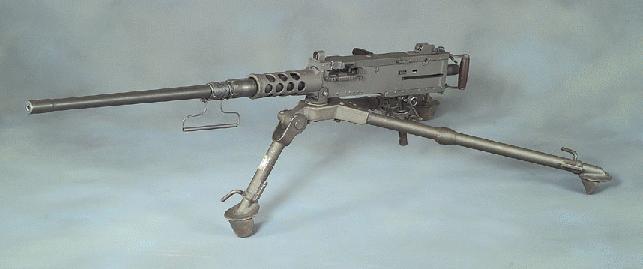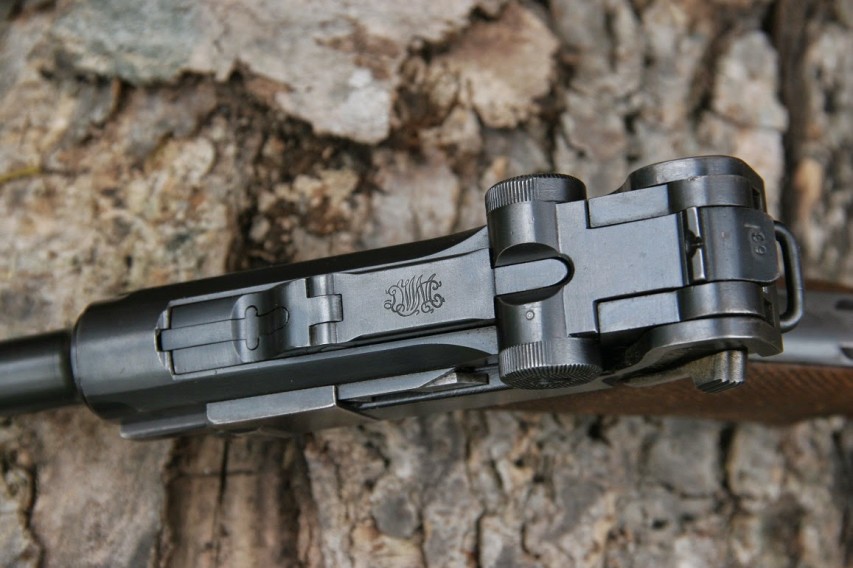Forgotten Weapons
Published 14 Mar 2018When the United States entered World War One, its military has a relatively tiny handful of machine guns, and they were divided between four different types, as the military budget was small and machine guns were not given much priority. However, since the failure of his gas-operated 1895 machine gun design to become a popular military item, John Browning had been working on a recoil-operated machine gun to replace it. This work became serious in 1910, and by 1915 Browning had met with Colt and agreed to give them exclusive license to his new design — and they began to work with him to refine and perfect it.
When the United States realized that it would be fighting in Europe and would need machine guns in 1917, it held an open trial for designs which Colt and Browning entered. The Browning gun was the undisputed star of the show, firing 40,000 rounds with only one parts breakage and no malfunctions that were not the fault of ammunition or belts. The gun was almost immediately adopted and pushed into production. Ultimately, Colt would allow the manufacture of its guns by Remington and New England Westinghouse, and Browning himself would accept a lump-sum royalty payment from the government for its use, which was about 3.5 million dollars less than he was contractually entitled to — out of patriotism and a desire not to profit too much from the war.
Browning 1917 machine guns would see only brief combat use in World War One, first tasting action in September of 1918. They would remain a staple of US military armament through World War Two, however, improved after the Armistice to the M1917A1 pattern. The gun we are looking at today is an original WW1 M1917, mounted on an equally rare M1917 original tripod.
http://www.patreon.com/ForgottenWeapons
Cool Forgotten Weapons merch! http://shop.bbtv.com/collections/forg…
If you enjoy Forgotten Weapons, check out its sister channel, InRangeTV! http://www.youtube.com/InRangeTVShow
April 30, 2020
Browning M1917: America’s World War One Heavy Machine Gun
March 15, 2020
M1918 BAR: America’s Walking Fire Assault Rifle
Forgotten Weapons
Published 14 Oct 2017Sold for $34,500 (transferrable).
John Browning developed the Browning Automatic Rifle for use by American troops in World War One, taking inspiration from the other light automatic weapons in service including the Chauchat, Lewis, and MG08/15. Rather than being used as a light machine gun as we would understand it today, the BAR was an “automatic rifle”, intended to be used in much the same way as the Germans would use the Sturmgewehr in WWII. It would be fired in semiautomatic mode from the shoulder or hip while advancing on the enemy, using steady fire to keep them pinned down. Once troops broke into close contact, the gun could be switched to fully automatic to provide overwhelming firepower for the final assault on a position. While the walking fire from the hip was not particularly realistic in practice, the fully automatic firepower was a huge boon to the infantry. While it filled the game role as the Chauchat, the BAR was a much more refined weapon and much easier to use effectively.
The BAR was showed to the US Ordnance Department in 1917, and the first order for them was placed with Colt in July of 1917. In short order further contracts would be placed with Winchester and Marlin-Rockwell, although it would take many months to fabricate the production tooling and perfect the design for mass production. A few hand-fitted guns were ready in February 1918 for a public demonstration, but significant quantities were not being built until July of 1918.
These guns would be shipped to France for use by the AEF, but not actually put into combat service until the Meuse-Argonne offensive in late September of 1918, due to General Pershing’s desire to keep them secret from the Germans until a large number could be used at once. As a result, the guns saw only very limited use before the war ended on November 11th. In total 102,173 BARs would be built, about half of them being finished into 1919, after the armistice. They would go on to be changed and updated for use in World War Two, but that is a discussion for another day. This particular gun is an excellent example of an M1918 BAR in correct World War One configuration, which is a rare find today.
http://www.patreon.com/ForgottenWeapons
Cool Forgotten Weapons merch! http://shop.bbtv.com/collections/forg…
If you enjoy Forgotten Weapons, check out its sister channel, InRangeTV! http://www.youtube.com/InRangeTVShow
February 18, 2020
FN Grand Browning: The European 1911 that Never Happened
Forgotten Weapons
Published 17 Feb 2020http://www.patreon.com/ForgottenWeapons
https://www.floatplane.com/channel/Fo…
Cool Forgotten Weapons merch! http://shop.bbtv.com/collections/forg…
When John Browning licensed his handgun patents, the North American rights were granted to Colt, and the Western European rights to FN in Belgium. Browning provided the patents and patent model guns to the companies, and they were then free to interpret the design however they thought best. In the case of the shrouded-hammer blowback system, the Colt interpretation (the Pocket Hammerless) was a civilian concealed pistol in .32ACP, while the FN interpretation (Model 1903) was a substantially larger gun in 9×20 Browning Long intended for military service.
The locked-breech patent was the same. Colt developed it into the Model 1911 adopted by the US military, and FN built a slightly smaller version in 9.65x23mm intended for European military service. However, while the Colt pistol became tremendously popular, FN’s development was disrupted by World War One, and never completed in its aftermath. Only a couple dozen examples of the Grand Browning, as it was called, were made before the war, and just a few survive today. We will never know how European militaries would have responded to a Browning locked-breech pistol at the time…
Contact:
Forgotten Weapons
6281 N. Oracle #36270
Tucson, AZ 85704
February 17, 2020
Development of the Model 1911 Pistol
Forgotten Weapons
Published 30 Nov 2014Cool Forgotten Weapons Merch! http://shop.bbtv.com/collections/forg…
When I was looking through the catalog for this upcoming Rock Island auction, I noticed that there were a lot of early-type Colt automatic pistols listed. I looked a bit closer, and noticed that there was, in fact, one of almost every major developmental variety. Well, that sounded like a recipe for a big overview video! So here I present the developmental history of the 1911.
These pistols sold for:
$10,350 (1900 Sight Safety)
$2,875 (1900/1902 Sporting)
$1,840 (1902 Sporting)
$2,875 (1902 Military)
$2,588 (1903 Pocket Hammer)
$6,900 (1905)
$16,100 (Savage 1907)
$2,300 (1911)
$3,738 (1924 Transitional)
$8,625 (1911A1)http://www.forgottenweapons.com
Theme music by Dylan Benson – http://dbproductioncompany.webs.com
February 2, 2020
Israeli M1919 Brownings and the US Semiauto Market
Forgotten Weapons
Published 28 Mar 2018Sold for $4,888.
In the world of converted semiautomatic “machine guns,” the Browning 1919 is a happy example of one of the most iconic and historically important US machine guns and also one of the cheapest semiautomatic belt fed guns available. This stems from two factors, primarily. One is that the Browning 1919, being developed from the water-cooled M1917 Browning, is a closed bolt system. Open bolt semiautomatic designs are not allowed by ATF, and so most semiauto machine gun conversions require substantial alteration to convert from open bolt to closed bolt — which the M1919 does not need. Second, the IDF used the Browning M1919 for many years and in large numbers, and surplussed many of them in the late 1990s. These guns came into the United States as parts kits in large numbers. This meant a glut of cheap guns, easily built as semi autos, and in an easily shootable caliber — 7.62mm NATO (as converted by Israel from their original .30-06 chambering).
Today, we are looking at an example of a semiautomatic converted M1919, and specifically at the various changes made by Israel to both improve the design and convert it successfully to the NATO cartridge.
http://www.patreon.com/ForgottenWeapons
Cool Forgotten Weapons merch! http://shop.bbtv.com/collections/forg…
If you enjoy Forgotten Weapons, check out its sister channel, InRangeTV! http://www.youtube.com/InRangeTVShow
November 27, 2019
John Browning vs Hiram Maxim: Patent Fight!
Forgotten Weapons
Published on 25 Sep 2019http://www.patreon.com/ForgottenWeapons
Cool Forgotten Weapons merch! http://shop.bbtv.com/collections/forg…
When John Browning designed his Model 1895 machine gun with its rotary-lever gas operation system, Hiram Maxim filed suit claiming patent infringement. Maxim had filed quite broad patents covering gas pistons operation, but specifically in a linear format. Browning and Colt (who had the license to manufacture the Model 1895 machine gun) countered that the swinging lever was a different system, and thus not covered by Maxim’s patents. More to the point, they claimed that the gun would work without using a gas piston at all – and built this experimental model using a gas trap or muzzle cap system instead to prove the point.
Ultimately, the genesis of the fight was moot (the Maxim did not run well in 6mm Lee Navy, and would not have won a US Navy contract regardless of the Colt/Browning gun), and the court ultimately decided in favor of Colt and Browning. But this gun remains from the incident…
Contact:
Forgotten Weapons
6281 N. Oracle #36270
Tucson, AZ 85704
September 6, 2019
Browning M2 .50cal “Ma Deuce” | HEAVY MACHINE GUN
Matsimus
Published on 22 Jul 2019The Browning heavy machine gun was designed towards the end of World War I. Development of a large-caliber machine gun in the USA was initiated at the direct request of General Pershing, the commander of US expeditionary corps in Europe. He requested a large-caliber machine gun, capable of destroying military aircraft and ground targets such as armored cars and tanks. The task of developing such a gun was passed to John Browning. The task of developing ammunition for this new weapon was passed to Winchester Arms company.
This machine gun is similar to John Browning’s earlier M1919 machine gun, that was chambered for a standard rifle cartridge. In around 1917 Browning started to redesign his weapon for a larger caliber. His new machine gun was chambered for much larger and much more powerful 12.7×99 mm (.50 caliber) cartridge, that was developed alongside this weapon by Winchester. That’s why sometimes this weapon is simply referred as Browning .50 caliber machine gun. After the John Browning’s death in 1926, the design of this weapon was finalized by other designers.
This machine gun entered service with the US armed forces in 1933 and was manufactured by Colt. Design of this weapon proved to be extremely successful. Since the 1930s it has been used extensively to the present day. This remarkable weapon has seen service during countless wars all over the world. Only during WWII nearly 2 million of these HMGs were produced. It has been in production longer than any other machine gun and its production still continues. Furthermore the M2 machine gun has been in use longer than any other small arm in the US armed forces inventory, except the M1911 pistol, that was also designed by John Browning. The M2 machine gun is currently manufactured by General Dynamics and US Ordnance companies. Since the 1930s this weapon is license-produced by FN Herstal of Belgium. Currently the M2 is used by about 100 countries all over the world. It is the primary heavy machine gun of NATO countries.
The M2 is typically used as a vehicle weapon or helicopter armament. It can be also used from a tripod. This heavy machine gun is highly effective against infantry, unarmored or lightly armored vehicles, boats, light fortifications and helicopters. It is closer in power to a small cannon.
This weapon is typically used with standard ball, tracer, armor-piercing, armor-piercing incendiary, or armor-piercing incendiary tracer rounds. There is also an M962 SLAP-T (Saboted Light Armor Penetrator) round, fitted with a tungsten penetrator.
The M2 is fed from disintegrating belt. Spent cartridge cases are extracted down. It can be adapted to feed from the left or right side of the weapon by reinstalling some parts. This conversion takes two minutes. The charging handle can be also changed from right to left hand side.
The M2 has slow and rapid firing modes. It can fire full-auto, as well as single shots. This weapon fires from a closed bolt.
When used as a crew served weapon, the M2 is mounted on an M3 tripod. This tripod weights 20 kg. So the complete weight of the machine gun on tripod is 58 kg. When fired from the tripod this HMG has an effective range of 1 830 m. Maximum effective range is 2 000 m.
The M2 comes with standard iron sights. However various types of telescopic and night sights can be installed using appropriate mountings.
Hope you enjoy!!
Want to support my channel? Check out my Patreon Donation page! https://www.patreon.com/user?u=3081754
Check out my Merch: https://teespring.com/stores/matsimus…
Wanna send me something? My PO Box: Matthew James 210A – 12A Street N Suite
#135 Lethbridge Alberta Canada T1H2J
Twitch: https://www.twitch.tv/matsimus_9033
DISCORD: https://discord.gg/B7cbXgy
Twitter: https://twitter.com/MatsimusGaming
(DISCLAIMER: This video is for informative and entertainment purposes only. The views and opinion come from personal experience and not that of others or other organizations. This content and information is there to provide information from public accessible sources.)
August 26, 2019
Belgian GP35: The First Military Browning High Power
Forgotten Weapons
Published on 29 Jul 2019http://www.patreon.com/ForgottenWeapons
Cool Forgotten Weapons merch! http://shop.bbtv.com/collections/forg…
The Grande Puissance — High Power — was John Browning’s last firearms design. In fact, he only began the design; it was taken to completion by his protege Dieudonné Saive at FN in Belgium. It was the best military handgun of the time, with a double-stack 13-round magazine capacity, and chambered for the 9x19mm cartridge. Belgium was the first nation to adopt it for military service, purchasing 1,000 guns for field trials and approving them in 1935 for standard issue as the GP-35.
The Belgian trials guns have a distinctive oval ejection port, which would be changed on production models. They were also fitted with flat board shoulder stocks and tangent sights adjustable up to 500 meters. These features would last until German occupation of the FN factory complex during World War Two, when the guns were simplified under German occupation production.
Contact:
Forgotten Weapons
PO Box 87647
Tucson, AZ 85754
April 10, 2019
M37: The Ultimate Improved Browning 1919
Forgotten Weapons
Published on 8 Mar 2019http://www.patreon.com/ForgottenWeapons
Cool Forgotten Weapons merch! http://shop.bbtv.com/collections/forg…
In November of 1950, the US Ordnance Department requested an improved version of the Browning 1919 air cooled machine gun for use in tanks. The new version was to be able to feed from either the left or right, a feature which was unimportant for an infantry gun but much more relevant when mounting guns into the tight spaces of an armored vehicle. An interim conversion of existing guns to the M1919A4E1 pattern came first, followed by manufacture of all-new guns by the Rock Island Arsenal and Saco-Lowell company from 1955 until 1957.
The design of the gun fell to Bob Hillberg at High Standard. He came up with a clever set of reversible plugs to change the bolt between left and right hand feed, as well as a captive recoil spring, manual safety, improved top cover and rear cover latches, and several other strengthened parts. He also incorporated a charging handle extension with integral manual hold open and a link ejection chute that could be mounted to either side of the gun. His T153 design was formally adopted as the M37, in caliber .30-06. A 7.62mm NATO version (the M37E1) followed as well. The M37 would serve into the late 1960s on the M48 and M60 tanks as well as several helicopters.
Contact:
Forgotten Weapons
PO Box 87647
Tucson, AZ 85754
March 17, 2019
Book Review: FN Browning Pistols by Anthony Vanderlinden
Forgotten Weapons
Published on 17 Feb 2019Get your copy here:
https://www.wetdogstore.com/NEW-FN-BR…Anthony Vanderlinden is a noted FN collector and author of a book on FN Mauser rifles as well as this volume on FN’s Browning pistols. Both are excellent reference works, with a remarkable amount of contextual information in addition to the very specific detail that appeal to the collector. This work begins with about 70 pages on the history of the FN company, detailing its work in firearms, automobiles, and other products through the Great War, the Great Depression, World War Two, and other events. It then spends a period discussing unique and interesting FN pistols, like the presentation guns made for FN’s celebration of producing a million Browning pistols and the guns used by Gavrilo Princip and his cohorts in the assassination of the Archduke Franz Ferdinand. There are then sections on FN’s association with John Browning and on Browning himself, and on the markings and proofs used by FN throughout its history.
The remaining bulk of the book is broken up into chapters covering the development, production, and use of each model of Browning pistol produced by FN (namely the 1899/1900, 1903, 1905, 1910, 1922, Baby Browning, and High Power). These chapters do an excellent job of providing information on the early development of the guns as well as the commercial and military production, often broken down by the different contracts for each model. For instance, the 1922 chapter includes sections on Yugoslav, Dutch, Mexican, Greek, Turkish, French, Romanian, Danish, Finnish, and German procurement of those pistols. For the historian, the context presented does an excellent job of explaining each gun’s significance in larger events. For the collector, the attention to the details of differences in marking and production between each different variant is thorough and very useful.
My only real complaint would be that the book is entirely in black and white. While that does not really hinder the purpose of the photographs in showing variations and such, color photographs would make it nicer to look at. The book was first printed in 2009, with a revised and expanded second edition printed in 2013. That second edition is available direct from Wet Dog Publications for $67.95 plus shipping, and also from Amazon.
http://www.patreon.com/ForgottenWeapons
Cool Forgotten Weapons merch! http://shop.bbtv.com/collections/forg…
Contact:
Forgotten Weapons
PO Box 87647
Tucson, AZ 85754
February 12, 2018
The Browning High Power pistol finally ends production after 82 years
Kyle Mizokami reported on this last week:
Small arms manufacturer Browning has ended production of the Browning Hi Power semiautomatic handgun. The legendary pistol served in armies worldwide, from Nationalist China to the British Special Air Service and was one of the first high capacity pistols ever invented. An invention of prolific arms designer John Moses Browning, the Hi Power was the inventor’s last pistol design.
As noticed by The Firearm Blog, the pistol‘s product page was quietly changed to include the words, “no longer in production” and the prices were removed. The Hi Power pistol was in continuous production for 82 years.
The Hi Power was the brainchild of American small arms legend John Moses Browning, a prolific inventor who also created the M2 .50 caliber machine gun, still in use with U.S. military forces today. He also invented the M1911 handgun, the U.S. military’s standard sidearm for nearly 70 years, and literally dozens of other pistols, shotguns, rifles, machine guns, and even a cannon. Browning was working on the Hi Power when he died in 1926, and the gun was eventually finished and sold by his manufacturing partners in Belgium in 1935.
The Hi Power had little in the form of commercial success before World War II, but was used by both sides during the war. Belgium’s surrender to Nazi Germany saw plans for the gun smuggled out of the country to Canada, where they were built for Nationalist Chinese forces and British and Canadian paratroopers and special forces. The tooling left behind in occupied Belgium went on to produce handguns for German military forces, particularly paratroopers and the Waffen SS. After the war the gun was sold to civilians and armed forces, particularly those belonging to NATO, and eventually more than 50 armies and 93 nations adopted the Hi Power as their standard sidearm. More than a million Hi Powers were eventually produced.
August 4, 2017
Experimental Lightweight Browning High Power
Published on 3 May 2017
One of the handguns that resulted from the post-WW2 interest in standardizing arms among the future members of NATO was a lightweight version of the Canadian produced Browning High Power. Experiments began in 1947 to create first a lightened slide by milling out unnecessary material, and then additionally with the use of machined and cast aluminum alloy frames. The first major batch of guns consisted of six with milled alloy frames, with two each going to the Canadian, American, and British militaries for testing.
This would reveal that the guns were in general quite serviceable, except that the locking blocks tended to distort their mounting holes in the alloy frames under extended firing. The cast frames were generally unsuccessful, suffering from substantial durability problems. The program was cancelled in 1951 by the Canadian military, and the last United States interest was in 1952. The example in today’s video is one of the two milled frame guns sent to the US for testing.
December 14, 2015
The eternal “Ma Deuce”
Strategy Page on one of the longest-serving (and still serving) weapons in the US arsenal:
A U.S. Army facility that is upgrading older 12.7mm (.50 caliber) M2 noticed that a lot of the guns coming in were quite old. M2 production began in 1921 and some three million have been produced since then. No one every kept track of how long M2s lasted. That question was recently answered when an M2 came in with serial number 324, meaning it was produced during the first year and was 94 years old. The serial number was on the receiver, the heaviest component of the M2 (25.5 kg/55 pounds in the most common version) and the one component that rarely wears out. In contrast the barrel is worn out after about 3,000 rounds and most other components eventually need replacement because of wear or damage. But the receiver is quite a sturdy block of machined metal.
Unfortunately for 324 the extent of the latest M2 upgrades means that it is often considered cheaper to scrap pre-World War II M2s rather than perform a number of accumulated fixes and modifications. But since 324 is the oldest to show up so far it will be displayed as a museum piece.
The M2 has lasted so long because it proved to be the most reliable and durable machine-gun of any caliber ever produced. That durability meant receivers would, if they could avoid battle damage or accidents, serve on and on. The army is seeing proof of that as more and more quite ancient receivers come back for which are mandatory and army-wide upgrades. Because of thus a lot of weapons NCOs have been checking their inventories and as they did that the word began spreading on the Internet (even army armorers have their own online forums) that there were a lot of very old M2 receivers out there.
January 29, 2015
Browning’s solution to the handgun problem
Last week, Tam saluted John Moses Browning on the occasion of his birthday, and celebrated the problem he solved:
So, the problem with a self-loading pistol is keeping the action closed until the bullet has left the muzzle and pressure in the chamber has dropped low enough that the brass case will be ejected neatly, as opposed to being transformed into a spray of shrapnel in the shooter’s face.
Early autopistols relied on complex mechanical setups, like the well-known Borchardt/Luger mechanism derived from Maxim’s toggle joint, to provide mechanical disadvantage against which the recoil had to work.
It would not shock me to learn that the two main parts of that toggle required more separate machining steps than an entire modern pistol slide. Further, the entire works were exposed to the great outdoors. Friend Marko once jokingly called it “The perfect handgun for a gunfight in a computer clean room.”
So, what are our choices to hold the breech closed for that crucial fraction of a second? Well, there’s spring pressure, but you can only add so much of that before the action can’t be worked by human hands. You can also add weight to the breechblock.

